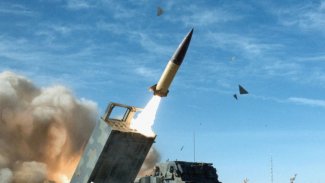Ukraine attacks with ATACMS missiles. Day 603 of war

Russia’s attacks and Ukraine’s counter-attacks in the area of Avdiivka have led to the formation of a new defence line to the north-west and south of the town along the railway line which runs through it. However, repeated attempts by the Russians to break through the Ukrainian defences west of Avdiivka failed. Also unsuccessful were the invaders’ repeated assaults on the defenders’ positions north and south-east of Kupyansk, on the border of Kharkiv and Lugansk oblasts, in the area of Marinka and south-east of Velyka Novosilka, as were the attacks both sides launched south-west of Bakhmut and south of Orikhiv. On 19 October, however, a spokesman for the Ukrainian Tavria operational-strategic group declared that Ukrainian forces had moved 400 metres south-west of the village of Verbove (south of Orikhiv).
According to Russian and Western sources, on 17 October two Ukrainian assault groups led a strike from a bridgehead on the left bank of the Dnieper (in the area of the railway bridge east of Oleshky, which borders Kherson across the river) and seized the villages of Poyma and (after bringing in reinforcements) Pishchanivka. A Russian counterattack drove the Ukrainians out of both villages, but the bridgehead was not eliminated. Two days later, Ukrainian sabotage and reconnaissance groups landed in the area of the village of Krynky to the west of Nova Kakhovka and temporarily occupied part of it, but were then pushed back to its outskirts. The Ukrainian side has consistently failed to report on its activities on the left bank of the Dnieper.
On 20 October, four Russian rockets hit Kostiantynivka in Donetsk oblast, and two (most likely from the S-300 system) hit the railway junction at Kupyansk-Vuzlovyi. The previous day, Russian missiles and kamikaze drones struck the cities of Dnipro, Kryvyi Rih (twice), Mykolaiv and Zaporizhzhia, where storage and industrial facilities were confirmed to have been hit. According to the Ukrainian Air Force command, the invaders used a total of eight missiles (five Iskander-M, one S-300, one Kh-59 and a cruise missile of undetermined type) and nine Shahed-136/131 drones; the defenders reportedly shot down one missile (the Kh-59) and three drones. In contrast, according to a communiqué from the Ukrainian General Staff on 19 October, the Russians used a total of 12 missiles. On 18 October, the target of the most serious attack was Zaporizhzhia city, which was hit by six of them. One missile hit a building in the centre of the city, leaving five people dead and five injured. It is uncertain whether this was a Russian missile that strayed off course or a missile from the S-300 system of Ukraine’s air defence. On the same day, Russian missiles also struck the cities of Dnipro (one person was killed and three injured), Kharkiv (hits on a commercial building were reported) and Pavlohrad in Dnipropetrovsk oblast (a chemical plant); a kamikaze drone also struck an infrastructure facility in Sumy. The Ukrainian General Staff reported that the invaders had used a total of 15 missiles, including Iskander missiles.
On 18 October, the Russian side reported further failed Ukrainian drone attacks. 12 drones were allegedly shot down over Kursk oblast, six over Belgorod oblast and 10 over the Black Sea. Later some Ukrainian media, citing sources in the Security Service of Ukraine, reported that a military camp located near Khalino airfield in Kursk oblast had been the target of the attack, and that at least 18 drones had hit it, causing massive damage. These reports have so far not been confirmed by any other source. Also on 18 October, Russian sources reported ineffective attacks by Ukrainian missiles (two Grom-2 missiles and one S-200) on Crimea.
On 17 October, US National Security Council spokeswoman Adrienne Watson confirmed that Ukraine had received a batch of ATACMS missiles, which have a range of 165 km. According to US media, over a dozen (per the Associated Press) or about 20 (the New York Times) missiles with M74 cluster warheads were handed over. Earlier, the Wall Street Journal reported that these missiles had been used on 17 October by the Ukrainian army to attack airports in occupied Berdyansk and Luhansk, which was confirmed the following day by the Ukrainian army’s Commander-in-Chief Valerii Zaluzhnyi. Initially, the perpetration was attributed to the Ukrainian Special Operations Forces, who reported that nine helicopters of various types, an air defence system launcher and ammunition depots had been destroyed in Berdyansk and Luhansk. Later satellite imagery confirmed varying degrees of damage to five helicopters in Luhansk and general damage (including to the runway) in Berdyansk. In contrast, British intelligence reported the destruction of nine helicopters in Berdyansk and five in Luhansk. In addition to the ATACMS missiles, the Ukrainians used GLSDB missiles (also fired from HIMARS launchers) in the attacks.
On 17 October, the US Army confirmed that all its 31 M1A1 Abrams tanks had been sent to Ukraine, along with the necessary ammunition and spare parts. Ukrainian soldiers training at a US base in Germany also returned to the country. On the same day, the Lithuanian defence ministry announced that the refurbishment of the Leopard tanks used by the Ukrainian army had started in Lithuania, in collaboration with the German industrial sector. On 20 October, during a meeting between the defence ministers of the US and Croatia in Washington, it was announced that the Croatian army had handed over all its Mi-8 helicopters to Ukraine (of which Croatia had 14; they had been withdrawn from service with the intention of delivering them to the Ukrainian army in March).
On 20 October, the Ukrainian finance ministry reported that in the first nine months of 2023, expenditure on security and defence reached 1.255 trillion hryvnia ($33.9bn), or 59.3% of the country’s total budget expenditure. In September alone, these outlays were expected to reach 141.9 billion hryvnias (c. $3.8bn).
On 19 October, the Black Sea Institute for Strategic Studies confirmed that since 16 October, a total of seven Bulgarian and Romanian vessels have launched anti-mine operations in their territorial waters. The vessels check the waterways used by the ships transporting grain and other goods from Ukrainian ports. Since mid-September, 32 vessels with a total carrying capacity of 1.4 million tonnes have passed through the Black Sea grain corridor.
On 18 October, Vladimir Putin announced that the Russian Air Force would intensify patrols over the Black Sea’s international waters, using MiG-31 type fighters armed with Kinzhal missiles. A spokesman for the Ukrainian Air Force said that the Russian president’s threats were aimed primarily at NATO countries, and that any appearance of such aircraft in the air would trigger alerts over most of Ukrainian territory. Satellite images show that the Russians have deployed four MiG-31 fighter jets at Crimea’s Belbek airfield in recent days.
On 18 October, the Ukrainian ministry of the economy reported that so far sappers have inspected and demined more than 225,000 hectares of the country’s agricultural land. In the last week alone, more than 5000 hectares of such land have been inspected. The vast majority of the areas inspected (almost 4200 hectares) were located in Kherson oblast, with the remainder in Mykolaiv and Kharkiv oblasts. The four-year plan for the reclamation of agricultural land envisages the demining of an area measuring around 470,000 hectares.
On 18 October, Ukraine’s State Special Communications Service indicated that in the first half of 2023, Ukrainian experts recorded increased activity by at least 23 Russian hacking groups. These attack not only army-related entities, but also the state administration, the economic sector and private users. Among the most dangerous and effective groups are UAC-0010 Gamaredon/Armageddon, controlled by the FSB, and UAC-0082 Sandworm, linked to military intelligence.
On 18 October, the Ukrainian President’s representative in parliament, Fedir Venislavsky, said that he was giving up his attempts to push through a law introducing criminal liability for men who had illegally left the country to avoid military service. He said that such a solution would probably prove ineffective (as it would be effectively impossible to ensure extradition from other countries) and counter-productive, as the threat of punishment would make such men even more reluctant to return to Ukraine. He cited the need to improve the country’s demographic situation as an argument in favour of making things easier for draft-dodgers.
Commentary
- The reports on Ukraine’s first use of ATACMS missiles indicate that the US has only partially fulfilled Kyiv’s months-long request for ballistic missiles which can strike targets in the invaders’ deep hinterland. The Ukrainians expected to receive the standard ATACMS missiles currently in use, which have a range of 300 km, but instead they were given the oldest version, the M39 (Block 1) with inertial guidance. According to some Western commentators, the US was told not to provide the newer GPS-guided missiles because of Russia’s signal jamming capabilities. In addition, only missiles with cluster warheads were handed over (as had already been suggested by the US media); these are mainly designed to destroy live forces and lighter-armoured targets. The ATACMS which were actually delivered could at most damage the targets under attack (as confirmed by the satellite images from Luhansk) without necessarily being able to destroy them. If the ammunition depots there were destroyed, it can only have been thanks to the GLSDB missiles which the Ukrainians were using at the same time; their range is only 15 km shorter than that of the ATACMS, and their main component is a 100-kilogram air bomb. The Block I missiles are certainly a valuable addition to the Ukrainian arsenal, but they do not give the defenders any new capabilities. The Ukrainians have much greater striking capabilities at their disposal thanks to the UK and France, who for several months have been providing them with Storm Shadow/SCALP cruise missiles with conventional warheads; these have a range of 250 km.






